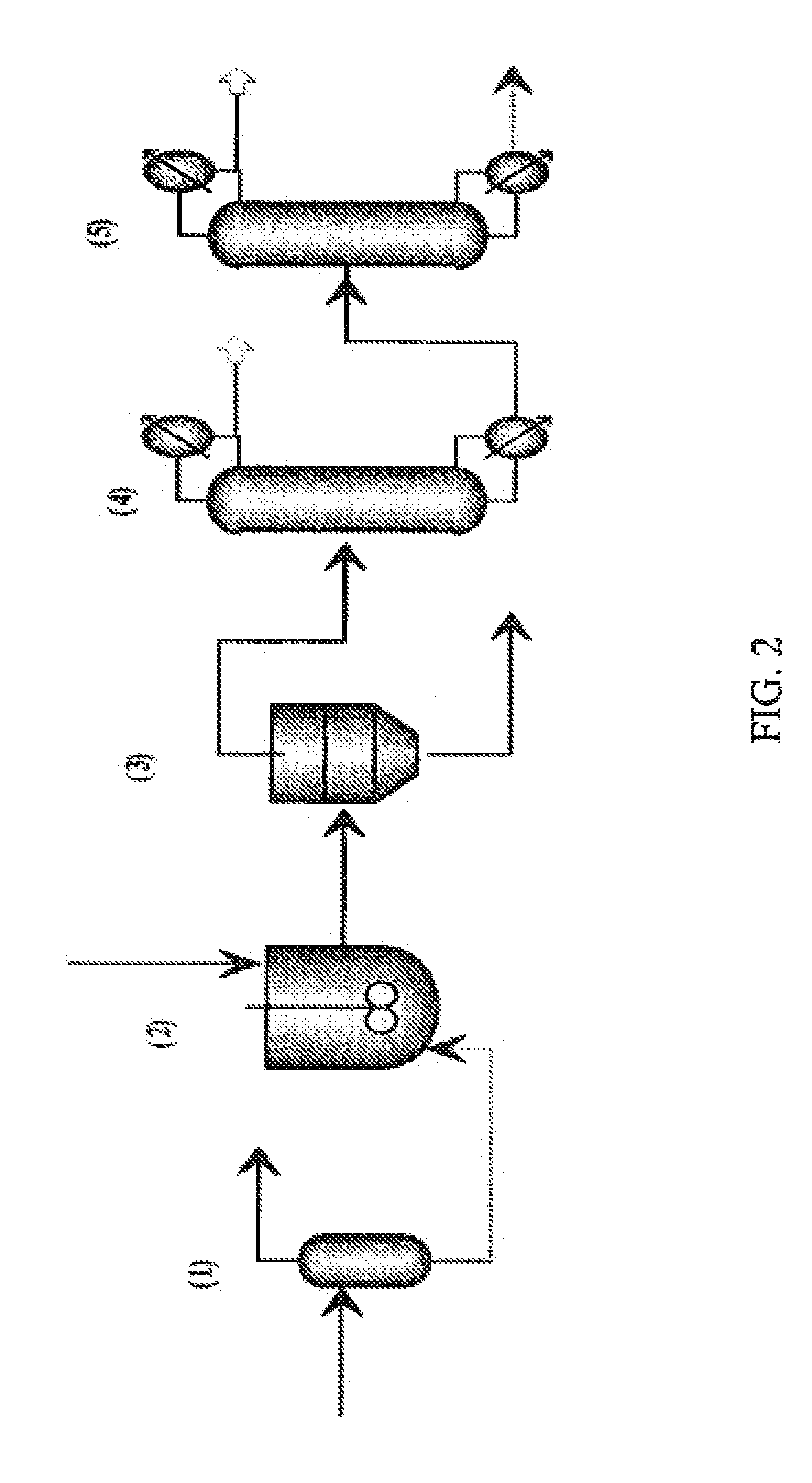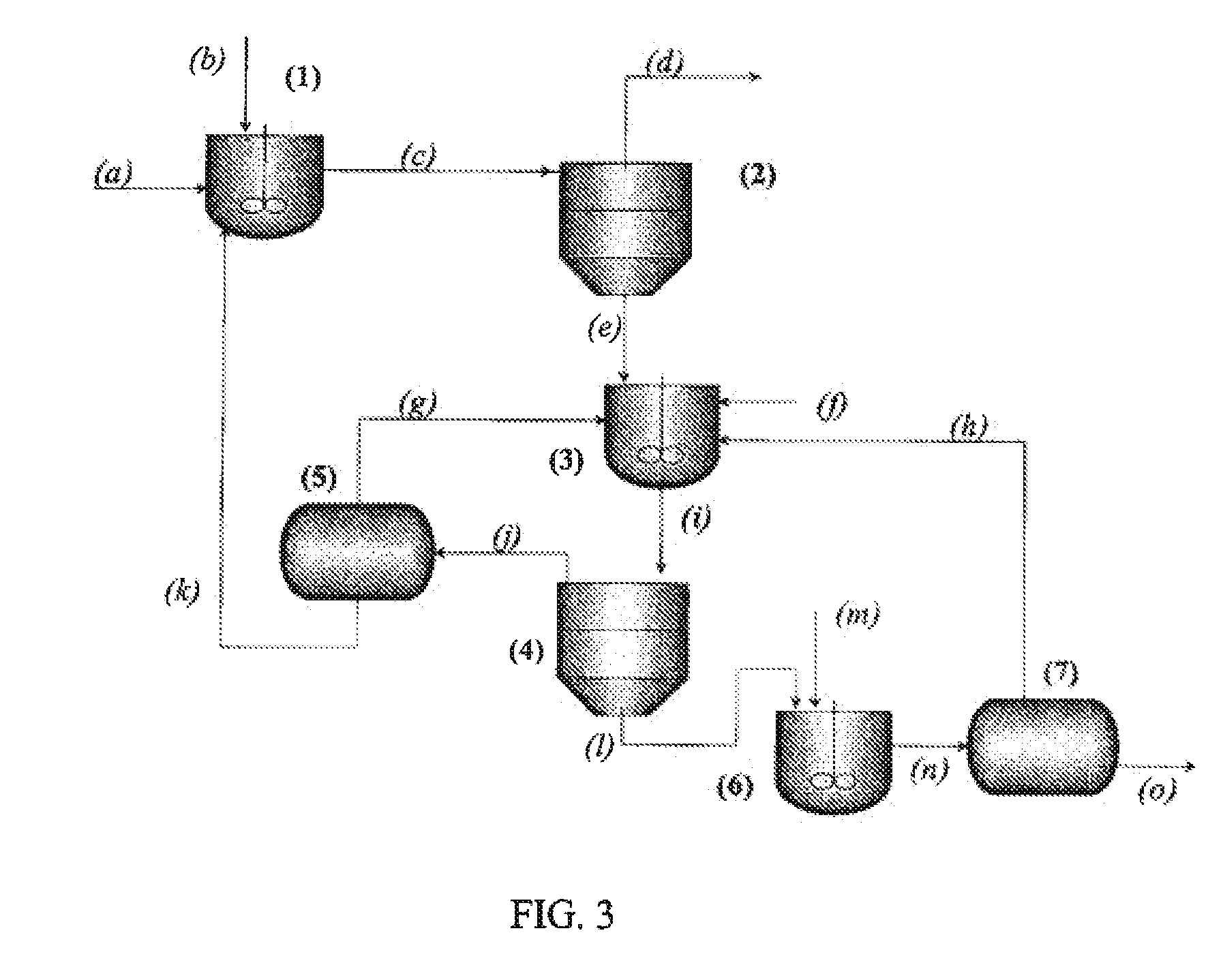Method for purifying an alcohol from a fermentation broth using a falling film, a wiped film, a thin film or a short path evaporator
a technology of evaporator and evaporation chamber, which is applied in the direction of solvent extraction, membranes, separation processes, etc., can solve the problems of high purification cost, high glycerol required to dissolve salts, and salt elimination, so as to achieve the effect of improving yield
- Summary
- Abstract
- Description
- Claims
- Application Information
AI Technical Summary
Benefits of technology
Problems solved by technology
Method used
Image
Examples
example 1
[0152]A filtered fermentation broth containing 1,3-propanediol (PDO) (A1) was used as a starting material for the following experiments.
[0153]Filtration of the fermentation broth comprised the two following steps:
[0154]1. 0.22 μm cutoff microfiltration
[0155]2. 30 kD cutoff ultrafiltration
[0156]The ultrafiltration permeate was analyzed by HPLC and results are reported in Table 1.
TABLE 1Composition of the microfiltered and ultrafiltered PDO fermentation broth(Mixture A1)Organic analysisIonic analysisConcentrationConcentrationCompoundg / lIong / lGlycerol14.4Na+2.81,3-propanediol (PDO)60.2NH4+6.5Acetate1.2K+0.7Butyrate11.2Mg2+ et Ca2+Lactate4.4Cl−4.2Ethanol0.6SO42−0.6PO43−0.6Water: qs 1L
[0157]The (A1) filtered fermentation broth was first concentrated by evaporation. (A1) Filtered fermentation broth (27 kg) was loaded into a thermosyphon-type evaporator. Operating top pressure was 130 mbar. 71.9 wt % of the solution was evaporated. The water content in the top product was higher than 99 wt...
example 2
[0165]A filtered fermentation broth containing 1,3-propanediol (PDO) (A2) was used as a starting material for the following experiments. The filtration of the fermentation broth comprised the two following steps:
[0166]1. 0.22 μm cutoff microfiltration
[0167]2. 30 kD cutoff ultrafiltration
[0168]The ultrafiltration permeate was analyzed by HPLC and results are reported in Table 3.
TABLE 3Composition of the microfiltered and ultrafiltered PDO fermentation broth(Mixture A2)Organic analysisIonic analysisConcentrationConcentrationCompoundg / lIong / lGlycerol5.1Na+2.31,3-propanediol (PDO)60NH4+4.6Acetate1.5K+0.6Butyrate12.3Mg2+ et Ca2+Lactate3.5Cl−4.3Ethanol0.3SO42−0.5PO43−0.6Water: qs 1L
[0169]The (A2) filtered fermentation broth was first concentrated by evaporation. (A2)
[0170]Filtered fermentation broth (25 kg) was loaded into a batch evaporator equipped with a rectification column. Operating top pressure was 500 mbar. 85 wt % of the solution was evaporated. The PDO weight fraction of the (B2...
example 3
[0174]The residue leaving the thin-film evaporator during the operation described in example 2 is used as a starting material for the following experiments (A3). That residue is mainly composed of glycerol, salts, and heavy compounds, and it contains the remaining 1,3 propanediol (PDO), which was not evaporated in the operation described in example 2. The composition of that mixture (A3) is described below: Glycerol and PDO weight fractions were determined by HPLC analysis, while salts and heavy compounds weight fractions are estimated based on the initial fermentation broth analysis, and on the various concentration factors of the previous purification steps. It is important to note that a major part of inorganic salts and of heavy impurities (e.g. protein decomposition products) is in the crystallized or precipitated form in mixture (A3). Thus, HPLC analysis results were corrected to obtain the real weight fraction of PDO or Glycerol in the whole mixture.
TABLE 4Composition of the ...
PUM
| Property | Measurement | Unit |
|---|---|---|
| Fraction | aaaaa | aaaaa |
| Fraction | aaaaa | aaaaa |
| Percent by mass | aaaaa | aaaaa |
Abstract
Description
Claims
Application Information
 Login to View More
Login to View More - R&D
- Intellectual Property
- Life Sciences
- Materials
- Tech Scout
- Unparalleled Data Quality
- Higher Quality Content
- 60% Fewer Hallucinations
Browse by: Latest US Patents, China's latest patents, Technical Efficacy Thesaurus, Application Domain, Technology Topic, Popular Technical Reports.
© 2025 PatSnap. All rights reserved.Legal|Privacy policy|Modern Slavery Act Transparency Statement|Sitemap|About US| Contact US: help@patsnap.com



